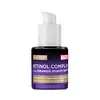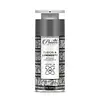Azarine Retinol Complex + 5x Ceramide Mighty Serum Versus Platinum Skincare Fusion A Retinoid Concentrate
What's inside
What's inside
 Key Ingredients
Key Ingredients

 Benefits
Benefits

 Concerns
Concerns

 Ingredients Side-by-side
Ingredients Side-by-side

Water
Skin ConditioningGlycerin
HumectantRetinol
Skin ConditioningDimethyl Isosorbide
SolventChlorphenesin
AntimicrobialSqualane
EmollientCeteareth-25
CleansingHydroxypinacolone Retinoate
Skin ConditioningCetyl Alcohol
EmollientPolyacrylate Crosspolymer-6
Emulsion StabilisingBehenic Acid
CleansingCholesterol
EmollientCeramide NP
Skin ConditioningCeramide Ns
Skin ConditioningCeramide Eos
Skin ConditioningCeramide EOP
Skin ConditioningCeramide AP
Skin ConditioningCaprooyl Phytosphingosine
Skin ConditioningCaprooyl Sphingosine
Skin ConditioningMannitol
HumectantPhosphatidylcholine
EmulsifyingRetinal
Skin ConditioningPotassium Sorbate
PreservativeSodium Benzoate
MaskingCitric Acid
BufferingSodium Chloride
MaskingWater, Glycerin, Retinol, Dimethyl Isosorbide, Chlorphenesin, Squalane, Ceteareth-25, Hydroxypinacolone Retinoate, Cetyl Alcohol, Polyacrylate Crosspolymer-6, Behenic Acid, Cholesterol, Ceramide NP, Ceramide Ns, Ceramide Eos, Ceramide EOP, Ceramide AP, Caprooyl Phytosphingosine, Caprooyl Sphingosine, Mannitol, Phosphatidylcholine, Retinal, Potassium Sorbate, Sodium Benzoate, Citric Acid, Sodium Chloride
Water
Skin ConditioningCaprylic/Capric Triglyceride
MaskingOctyldodecanol
EmollientDimethicone
EmollientCetyl Alcohol
EmollientPropanediol
SolventDimethiconol
EmollientSqualane
EmollientDimethyl Isosorbide
SolventGlyceryl Stearate
EmollientGlycol Stearate
EmollientSodium Acrylate/Sodium Acryloyldimethyl Taurate Copolymer
Emulsion StabilisingPolysorbate 20
EmulsifyingRetinal
Skin ConditioningPEG-20
HumectantPhospholipids
Skin ConditioningHydroxypinacolone Retinoate
Skin ConditioningGlycerin
HumectantRetinol
Skin ConditioningCeramide NP
Skin ConditioningAscorbic Acid
AntioxidantPhenoxyethanol
PreservativeEthylhexylglycerin
Skin ConditioningWater, Caprylic/Capric Triglyceride, Octyldodecanol, Dimethicone, Cetyl Alcohol, Propanediol, Dimethiconol, Squalane, Dimethyl Isosorbide, Glyceryl Stearate, Glycol Stearate, Sodium Acrylate/Sodium Acryloyldimethyl Taurate Copolymer, Polysorbate 20, Retinal, PEG-20, Phospholipids, Hydroxypinacolone Retinoate, Glycerin, Retinol, Ceramide NP, Ascorbic Acid, Phenoxyethanol, Ethylhexylglycerin
Ingredients Explained
These ingredients are found in both products.
Ingredients higher up in an ingredient list are typically present in a larger amount.
Ceramide NP is a type of ceramide and formally known as ceramide 3.
Ceramides are intercellular lipids naturally found in our skin that bonds dead skin cells together to create a barrier. They are known for their ability to hold water and thus are a great ingredient for dry skin.
Ceramides are an important building block for our skin barrier. A stronger barrier helps the skin look more firm and hydrated. By bolstering the skin ceramides act as a barrier against irritating ingredients. This can help with inflammation as well.
If you would like to eat ceramides, sweet potatoes contain a small amount.
Read more about other common types of ceramides here:
Ceramide AP
Ceramide EOP
Cetyl Alcohol is a fatty alcohol. Fatty Alcohols are most often used as an emollient or to thicken a product.
Its main roles are:
Though it has "alcohol" in the name, it is not related to denatured alcohol or ethyl alcohol.
The FDA allows products labeled "alcohol-free" to have fatty alcohols.
Learn more about Cetyl AlcoholDimethyl Isosorbide is a low-irritation solvent that helps deliver actives into your skin. It is created from glucose.
Research shows how well this ingredient works depends on the active and formulation rather than the concentration alone. This means adding more Dimethyl Isosorbide does not guarantee better penetration of ingredients into the skin.
Glycerin is already naturally found in your skin. It helps moisturize and protect your skin.
A study from 2016 found glycerin to be more effective as a humectant than AHAs and hyaluronic acid.
As a humectant, it helps the skin stay hydrated by pulling moisture to your skin. The low molecular weight of glycerin allows it to pull moisture into the deeper layers of your skin.
Hydrated skin improves your skin barrier; Your skin barrier helps protect against irritants and bacteria.
Glycerin has also been found to have antimicrobial and antiviral properties. Due to these properties, glycerin is often used in wound and burn treatments.
In cosmetics, glycerin is usually derived from plants such as soybean or palm. However, it can also be sourced from animals, such as tallow or animal fat.
This ingredient is organic, colorless, odorless, and non-toxic.
Glycerin is the name for this ingredient in American English. British English uses Glycerol/Glycerine.
Learn more about GlycerinThis ingredient is a retinoid. It usually goes by a more common name: "Granactive".
Hydroxypinacolone Retinoate (HPR) belongs to the class of retinoids that also includes retinol and tretinoin.
Retinoids have been proven to:
So what is the difference between all the retinoids?
Most retinoids need to go through a conversion line to become effective on skin. The ending product is retinoic acid. Retinoic acid is AKA tretinoin.
HPR is an ester of tretinoin. Emerging studies suggest HPR to have an added benefit that other retinoids don't have: Low irritation.
A study from 2021 found HPR to have the greatest stability when exposed to light and temperature out of all the commercial retinoids.
A note about naming:
The name "Granactive" is the trade name and the name most commonly used on packages.
Granactive is the name of the mixture - about 90% solvent and 10% HPR. A product with 5% granactive has 0.5% HPR.
Learn more about Hydroxypinacolone RetinoateRetinal is a form of retinoid. Retinoids are the gold-standard class of anti-aging ingredients.
Retinal has many benefits as other retinoids: improve skin texture, reduce large pores, reduce the effects of aging, reduce the visibility of dark spots, heal scars, and fight acne.
Studies show retinal may work at a faster rate than retinol due to its structure.
All retinoids have to be converted into retinoic acid before starting to work. Some retinoids take several steps of conversion before binding. Retinal is only one step away, making it more potent.
Like other retinoids, retinal may be irritating. It is best to ease into using this ingredient frequently.
Using the 'ramp up' method, start by using retinol once a week. This gives your skin time to adjust and decrease irritation. Once you feel ready, you can slowly increase the frequency of retinol use.
Using retinoids will increase sun-sensitivity in the first few weeks of use. Though studies show retinoids increase your skin's natural SPF with continuous use, it is best to always wear sunscreen and sun-protection.
Learn more about RetinalRetinol is a gold-standard ingredient for anti-aging. It is a form of Vitamin A and belongs to the class of retinoids that also includes tretinoin.
Why is retinol famous?
It has the most scientific studies backing up its skin benefits out of all the non-prescription ingredients.
Retinol is proven to:
This is why retinol is effective at removing wrinkles, fading dark spots, treating acne, and reducing the appearance of pores.
Studies show retinol is less effective when exposed to UV. Be sure to look for appropriate packaging to keep your retinol potent (similar to Vitamin C).
Using retinol or any retinoids will increase sun-sensitivity in the first few months. Though studies show retinoids increase your skin's natural SPF with continuous use, it is best to always wear sunscreen and sun-protection.
We recommend speaking with a medical professional about using this ingredient during pregnancy.
Retinol may cause irritation in some people, so be sure to patch test. Experts recommend 'ramping up' retinol use: start using this ingredient once a week and work up to using it daily.
Read about Tretinoin
Learn more about RetinolSqualane is an emollient that helps the skin hold onto moisture. It's an oily liquid that occurs naturally in certain types of fish and plant oils.
Because squalane boosts hydration in the skin, it also comes with plenty of benefits: it is an antioxidant and can help fight free radicals and skin damage. Squalane is also found to have a detoxifying effect when applied.
Squalane comes from squalene, which occurs naturally within the sebum of our skin. It is one of the oils our skin produces to keep itself hydrated. Squalane is the hydrogenated version of squalene and has a longer shelf life.
Research shows that squalane is non-irritating (even at 100% concentration).
In general, it's a fantastic ingredient. It does a great job at hydrating the skin, and it's suitable for those with sensitive skin.
The source of squalane may impact malassezia / fungal acne. This is because olive oil derived squalane can contain impurities such as fatty acids and plant waxes. Sugarcane derived squalane is recommended for anyone with malassezia concerns.
Is squalane vegan?
This depends on the source. Squalane can be derived from both plants and animals. Most squalane used in skincare comes from plants.
Please note: the source of squalane is only known if disclosed by the brand. We recommend reaching out to the brand if you have any questions about their squalane.
Read more about squalene with an "e".
Is squalane an oil?
Squalane is often called an oil, but it’s technically not; it’s a hydrocarbon, meaning it’s only made of carbon and hydrogen, unlike true oils which are triglycerides made of fatty acids and glycerol.
The term “oil-free” isn’t regulated, so companies can define it however they want. Some exclude all oils, while others just avoid mineral oil or comedogenic oils.
While some people avoid oils thinking they cause breakouts, the right kind of oil (or oil-like ingredient like squalane) can actually help balance and hydrate your skin. It’s worth testing out simple oils or squalane to see what works best for your skin.
Learn more about SqualaneWater. It's the most common cosmetic ingredient of all. You'll usually see it at the top of ingredient lists, meaning that it makes up the largest part of the product.
So why is it so popular? Water most often acts as a solvent - this means that it helps dissolve other ingredients into the formulation.
You'll also recognize water as that liquid we all need to stay alive. If you see this, drink a glass of water. Stay hydrated!
Learn more about Water